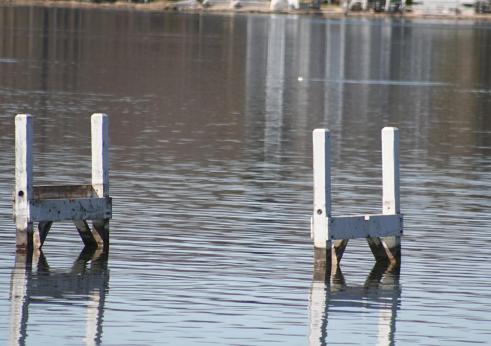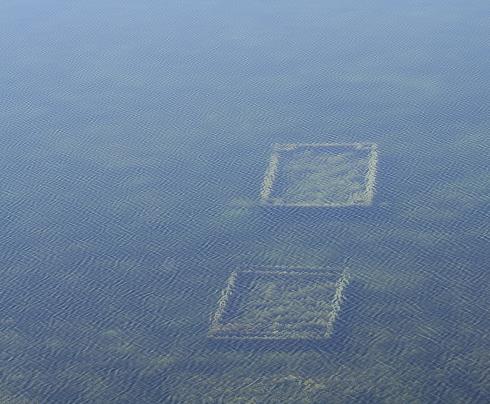
I bought my first car when I was 15. It was a truck actually, and I was still 6 months shy of my 16th birthday when I became the proud new owner of a 1984 Dodge Ram pickup. The truck was white and shiny, but even more impressive were the brand new rims that the previous owner put on it for me- unexpectedly- prior to delivery. Even though I owned the truck ($1700 was the price- I think), I couldn’t do anything with it but look at it. I couldn’t drive it, and cleaning vehicles has never been one of my passions, as anyone who has seen my car can attest. That truck sat in my parents driveway for six long, tedious months, teasing me with the promise of tire screeching freedom. The truck has now been replaced by the very cold, fabulously clear waters of Geneva Lake. The water is there, waiting for me, no- calling to me, yet I can do very little with it yet but look at it and dream. My infatuation with my new truck ended one sweaty evening when I clipped the rear bumper of a parked car and smashed up the passenger side of that previously shiny truck, but my infatuation with the calming waters of Geneva Lake has never waned.
Today, the lake is still roughly 30% covered in ice. Williams Bay, Fontana, and East towards Knollwood is free of ice, but the narrows and all of Geneva Bay remain covered in an ever weakening layer of frozen water. It was a rare occurrence, given the partial ice cover, to see the first pier of the year being installed yesterday at the Williams Bay lakefront. I snapped a few pictures, and filmed a shaky video, which you’ll find embedded below. The water is so incredibly clear right now that the somewhat ghostly skeletons of the thousands of cribs that support the piers are visible from shore. Seeing those cribs yesterday made me realize I should probably provide a quick introduction to pier building for those of you who are Lake Geneva novices.

Welcome to Lake Geneva Pier 101. First off, we will always call a pier a pier. Never a dock. Dock’s are made out of metal and may or may not have old tires serving as boat bumpers. Piers are traditionally constructed out of Douglas Fir, and are put together like a giant, wooden, water soaked, erector set. In building a pier, the first step is to construct the “cribs”. Cribs are wood structures built with square openings in the four corners of the structure. They are built out of wood, on land, and then brought to the lake where they are positioned and sunk into place by filling up the crib interior with rocks. The four square openings are made just large enough to receive the primary pier support structures, called horses. These horses are made of 6×6 or 8×8 Douglass Fir, and are serve as the primary support for the pier. They are essentially half in the water, and half out. They are painted white, but are not otherwise waterproofed. Remember that. They should always be painted white. Piers are also quite expensive, and a new “from scratch” pier can cost upwards of $30,000. Usually homeowners will replace the pier a little at a time, so the cost is never more than an extra thousand bucks each year. There are myriad pier companies who maintain piers for lakefront homeowners, and very few owners handle pier maintenance in the hands on fashion of my own father. David, come down here and help me build this horse!
Long wooden boards called stringers are then bolted between the horses, and serve to hold the walking planks that will lay perpendicular to the stringers, their edges resting securing on the tops of the stringers. Once the horses are positioned upright into the cribs, the stringers are bolted on, then the walkway planks are laid on top of the stringers. This will provide the basic pier, though many piers on Geneva are canopied, meaning they have an additional wooden structure that supports a canvas canopy designed to cover the boat. These canopies are historically striped, but they can be solid colors as well. It’s usually best to pick a color that matches either your boat or your house. Orange, purple and black are colors that should never find their way onto a canopy. The South Shore Club canopies provide a fine example of a proper style and color canopy.
Piers are installed in the spring and removed in the fall, usually going in sometime during April and early May, and coming out towards the end of October or early November. They aren’t left in the water because of the crushing power of Lake Geneva ice. Many a left pier has met an untimely demise by being carried off to sea during the famous spring ice shifts. A traditional pier will cost between $700 and $1000 to install, and the same to remove. Piers must be painted white according to tradition, though you can legally paint your pier any color you wish. William Wrigley Junior has a brown pier, and I, for one, don’t care for it much. Pier painting is either done professionally or by college kids, and will run between $200 and $500 per year depending on the size and configuration of your pier. I hate painting most things, including piers.
Thus ends Pier 101. If you’re lucky enough to own a Lake Geneva pier, I tip my imaginary hat to you. If you’d like to have your very own Lake Geneva pier, please see me after class.

Thanks for the update. You do a great job filling the void when I’m away from the lake.
Thanks Dan. I’m more than happy to help! David
good top comment
Thanks for your article, My Boyfriend and I paint piers and like you have a love for Geneva Lakes water. My Boyfriend had the luxury of growing up with the lake as his back yard. He has spent countless years building, painting, installing and taking the pier out of the water. We take great pains to make sure that we do not pollute the water with paint chips as best we can. I myself become very excited when I see piers going in it means summer is on its way.
What is Lake Geneva white paint? Is it a brand? Is it a certain special white? I like the idea that what you use doesn’t chip off.
Thirteen years later, this is still finding its way to people wanting to learn the how and why. Thank you!
Thank you for your note. That’s nice to hear…